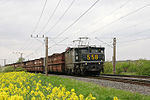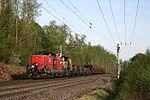Rail vehicles from Rheinbraun
Locomotives
The routes of the works railway of the company RWE Power (formerly Rheinbraun ) in the Rhenish lignite area , in particular the north-south railway and the Hambach railway , differ from the traction current voltage customary in Germany (15 kV at 16.7 Hz) with single-phase alternating current of 50 Hz at a nominal voltage of 6 kV electrified. Due to the large transport volumes, the locomotives have to have a high tractive force, so the electric locomotives are all special developments. Furthermore, some locomotives of the EL 1 series were the first electric locomotives in the world to be put into operation with thyristor control and were thus a milestone in the development of electric traction vehicles.
Even if the majority of the lines are electrified, diesel locomotives were and are mostly kept within the factories and for shunting purposes, the larger ones are also used in line service in front of light trains. However, in contrast to the electric locomotives, the diesel locomotives correspond to the standard types of the respective manufacturers.
| model series | Company number | number | Year of construction (s) | Manufacturer | Wheel alignment | power | Service weight | Remarks | image |
|---|---|---|---|---|---|---|---|---|---|
| Tbsp 1 |
500–635 with gaps |
107 | 1954-1965 |
Krupp , Henschel , Krauss-Maffei AEG , BBC , SSW |
Bo'Bo ' | 4 × 655 kW | 126 t (Krauss-Maffei); 139 t (Krupp) | partially retired |

|
| Tbsp 2 | 682-693 | 12 | 1950-1954 | various | Bo'Bo ' | 4 × 275 kW | 90 t - 100 t | Retired , due to the different power system of 1.2 kV direct current, the EL2 were only used on certain routes. | |
| EL 4 |
1035-1048 (1983) |
10 (1983), total 117 | approx. 1948–1956 | Henschel Siemens- Schuckert works |
Bo'Bo ' | 4 × 190 kW | 75 t | 40 km / h gauge 900 mm retired in 1988 Alt-Hürth monument railway |

|
| EL 2000 | 501-510 | 10 | 1999 | ADtranz | Bo'Bo ' | 4 × 760 kW | 140 t | Top speed 70 km / h |

|
| Company number (s) | number | Year of construction (s) | Manufacturer | design type | Wheel alignment | power | Remarks | image |
|---|---|---|---|---|---|---|---|---|
| 450-452 | 3 | 1948-1951 | Deutz / KHD | V6M436R | C dm | 265 kW / 360 PS | retired | |
|
453-455 and 458-460 |
6th | 1955-1956 | Krauss Maffei | ML500C | C dm | 367 kW / 500 PS | retired | |
| 457 | 1 | 1948 | Deutz / KHD | A6M517R | B dm | 79 kW / 107 PS | retired | |
| 462-470 | 9 | 1954-1958 | Deutz / KHD | T4M625R / KS230B | B dm | 169 kW / 230 PS | retired | |
|
471–481 except 474/477 |
9 | 1963 | Deutz / KHD | MG530C | C ie | 390 kW / 530 PS |

|
|
| 474 / 477 | 2 | 1963 | Deutz / KHD | DG 1000 BBM | Bo'Bo 'ie | 736 kW / 1000 PS |

|
|
| 482-483 | 2 | 1955-1958 | Croup | 200 hp | B ie | 147 kW / 200 PS | re-tracked from 900 mm | |
| 484-485 | 2 | 1983 | Gmeinder | D 60 C | C ie | 463 kW / 600 PS |

|
|
| 486 | 1 | 1993 | Gmeinder | D 100 BB | Bo'Bo 'ie | 736 kW / 1000 PS |

|
|
| 488 | 1 | 1961 | Deutz / KHD | DG 1000 BBM | Bo'Bo 'ie | 736 kW / 1000 PS | Bought in 2006 |

|
| 489 | 1 | 2012 | Vossloh | MaK G 1206 | Bo'Bo 'ie | 1500 kW |

|
|
| 490 | 1 | 2015 | Voith | Voith Gravita 10 BB | Bo'Bo 'ie | 1000 kW |

|
Wagons and other vehicles
Since the Rheinbraun industrial railway mainly transports lignite and other bulk goods, the majority of the rolling stock consists of various types of bulk goods wagons, including the one-way tippers that are characteristic of lignite mining. Dust wagons are also used to transport coal dust .
A large number of other vehicles are kept available, mainly for maintenance and track construction purposes, as well as a MAN rail bus (number 808, manufacturer MAN) for route trips and special trips.
See also
literature
- Günter Barths: The traction vehicles of the Rhenish lignite works in words and pictures , Röhr Verlag, Krefeld, 1982
Web links
- Extract from Bahn-Express , September 6, 2006
- Impressions from the EL2000
- Information and pictures from the north-south runway of the Rheinbraun
- Photos of Rheinbraun rail vehicles
- Photos of the 900 mm mine railway "United Ville"
- Accident of locomotive 477 on November 10, 2008
- Monument in Alt-Hürth club side